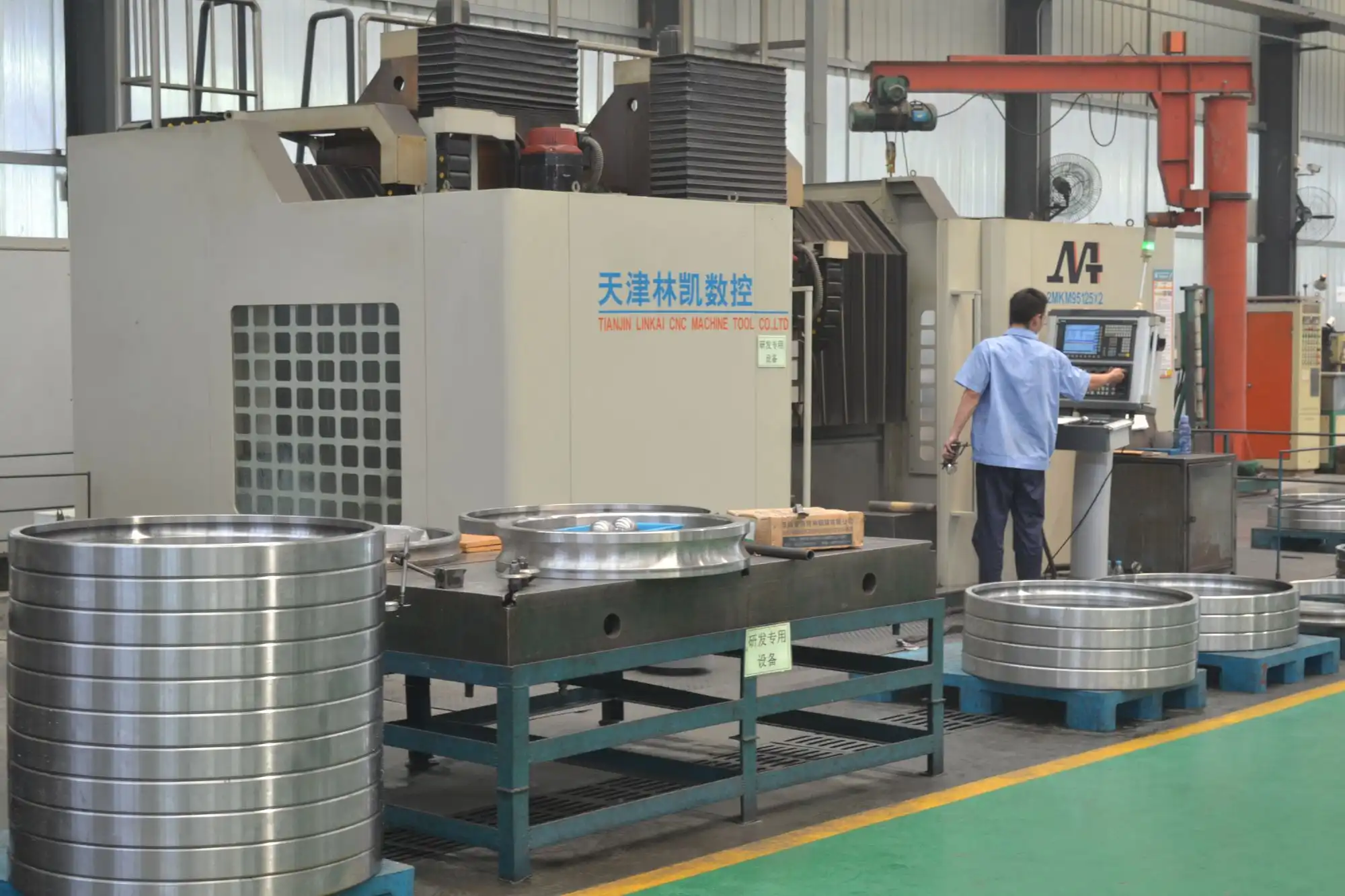Rolling Mill Bearings: Load Capacity and Performance Factors
Rolling Mill Bearings are critical components in the metal processing industry, designed to withstand extreme conditions and ensure smooth operation of rolling equipment. These specialized bearings play a crucial role in maintaining precision, reducing friction, and supporting high loads in various rolling mill applications. Understanding the load capacity and performance factors of rolling mill bearings is essential for optimizing production efficiency and equipment longevity. This article delves into the key aspects that influence the performance of rolling mill bearings, including their design features, material composition, and operational considerations. We'll explore how these factors contribute to the bearings' ability to handle the demanding requirements of rolling mills, from hot strip production to cold rolling processes. By examining the interplay between load capacity, speed ratings, and environmental factors, we aim to provide insights that can help engineers and maintenance professionals make informed decisions when selecting and maintaining rolling mill bearings.
What are the key factors affecting Rolling Mill Bearing performance?
Load Capacity Considerations
The load capacity of Rolling Mill Bearings is a critical factor that directly impacts their performance and longevity. These bearings are designed to withstand enormous radial and axial forces encountered in rolling mill operations. The static load rating indicates the maximum load a stationary bearing can endure without permanent deformation, while the dynamic load rating represents the load at which the bearing will achieve a specific lifespan under typical operating conditions. For Rolling Mill Bearings, manufacturers often use high-quality materials such as through-hardened steel or case-carburized steel to enhance load-bearing capacity. The bearing's geometry, including the number and size of rolling elements, also plays a crucial role in determining its load capacity. Larger rollers or a greater number of rollers can distribute the load more effectively, increasing the bearing's overall capacity. Additionally, the cage design in Rolling Mill Bearings is optimized to ensure proper spacing and guidance of the rolling elements, further contributing to their ability to handle high loads efficiently.
Speed and Heat Management
Speed is another critical performance factor for Rolling Mill Bearings. These bearings often operate at high speeds, which can generate significant heat due to friction. Effective heat management is essential to prevent premature bearing failure and ensure optimal performance. Rolling Mill Bearings are typically designed with features that facilitate heat dissipation, such as enhanced lubrication systems and specialized sealing arrangements. The choice of lubricant is crucial, as it must maintain its viscosity and protective properties under high-temperature conditions. Some advanced Rolling Mill Bearings incorporate innovative cooling systems, including oil circulation or even water-cooled designs for extreme applications. The bearing's internal geometry is also optimized to minimize friction and heat generation at high speeds. This includes the use of roller profiles that reduce skidding and promote smooth rolling contact. Furthermore, the clearance and preload of the bearing are carefully controlled to maintain proper operation across a wide range of speeds and temperatures, ensuring consistent performance throughout the rolling process.
Environmental Resistance
The harsh environment in rolling mills presents significant challenges for bearing performance. Rolling Mill Bearings must resist contamination from metal particles, scale, and other debris that are common in these industrial settings. To address this, manufacturers employ advanced sealing technologies, such as multi-lip seals or labyrinth seals, to prevent ingress of contaminants. The material composition of the bearing components is also selected for its resistance to corrosion and wear. Some Rolling Mill Bearings feature special coatings or surface treatments that enhance their durability in aggressive environments. Additionally, the design of the bearing housing and lubrication system plays a crucial role in environmental resistance. Proper lubrication not only reduces friction but also helps to flush out contaminants and protect the bearing surfaces. In some cases, positive pressure lubrication systems are employed to create a barrier against external contaminants. The ability of Rolling Mill Bearings to maintain their performance under these challenging conditions is essential for minimizing downtime and extending the operational life of rolling mill equipment.

How do Rolling Mill Bearing designs vary for different mill types?
Hot Strip Mill Applications
Rolling Mill Bearings used in hot strip mills face some of the most demanding conditions in the industry. These bearings must withstand extremely high temperatures, often exceeding 1000°C, as well as significant loads and speeds. For such applications, specialized Rolling Mill Bearings are designed with enhanced thermal management capabilities. This may include the use of heat-resistant materials, such as high-chrome steels or even ceramic rolling elements in extreme cases. The bearing design often incorporates features to accommodate thermal expansion and maintain proper clearances at elevated temperatures. Lubrication systems for hot strip mill bearings are particularly critical, often utilizing high-temperature greases or circulating oil systems to ensure adequate lubrication and cooling. Some Rolling Mill Bearings for this application may also feature advanced sealing solutions to protect against the ingress of scale and other hot debris. The overall design aims to balance the need for high load capacity with the ability to operate reliably under extreme thermal conditions.
Cold Rolling Mill Requirements
Cold rolling mills present a different set of challenges for Rolling Mill Bearings. While the temperature conditions are less extreme than in hot mills, the precision requirements are often higher. Cold rolling processes demand extremely tight tolerances and smooth operation to achieve the desired surface finish and dimensional accuracy of the rolled product. Rolling Mill Bearings for these applications are designed with a focus on high precision and stiffness. This often involves the use of pre-loaded bearing arrangements to minimize radial and axial play. The bearing geometry is optimized to provide maximum contact area between the rolling elements and raceways, ensuring uniform load distribution and minimizing deflection under load. In some cases, hybrid bearings with ceramic rolling elements are used to achieve higher speeds and better precision. Lubrication systems for cold rolling mill bearings are designed to provide consistent, minimal lubrication to reduce friction while avoiding over-lubrication that could affect the surface quality of the rolled product.
Specialized Mills and Custom Solutions
Beyond standard hot and cold rolling mills, there are numerous specialized mill types that require customized Rolling Mill Bearing solutions. For example, sendzimir mills used in the production of thin gauge materials require bearings capable of withstanding extremely high loads in a compact design. These may incorporate multi-row cylindrical roller bearings or specialized tapered roller bearings to achieve the necessary load capacity. In section mills, where complex profiles are produced, Rolling Mill Bearings may need to accommodate misalignment or deflection of the mill stands. This can be addressed through the use of self-aligning bearing designs or specialized housing arrangements. For continuous casting applications, where the bearings support the rolls that guide the solidifying metal, special attention is given to sealing and lubrication to protect against the ingress of cooling water and scale. In each of these specialized applications, Rolling Mill Bearing manufacturers work closely with mill designers to develop custom solutions that meet the specific operational requirements and constraints of the mill type. This may involve innovative bearing designs, material selections, or lubrication systems tailored to the unique challenges of each application.

What are the latest innovations in Rolling Mill Bearing technology?
Advanced Materials and Coatings
The field of Rolling Mill Bearing technology has seen significant advancements in materials science and surface engineering. Manufacturers are now developing bearings with novel alloys that offer improved hardness, wear resistance, and thermal stability. For instance, some Rolling Mill Bearings now incorporate high-nitrogen steels or powder metallurgy materials that provide enhanced performance under extreme loads and temperatures. Surface coatings have also evolved, with the introduction of diamond-like carbon (DLC) coatings that reduce friction and improve wear resistance. These coatings can significantly extend the service life of Rolling Mill Bearings, particularly in boundary lubrication conditions. Another area of innovation is the development of ceramic hybrid bearings, which use ceramic rolling elements in combination with steel rings. These bearings offer benefits such as reduced weight, higher speed capabilities, and improved electrical insulation properties, which can be advantageous in certain rolling mill applications.
Smart Bearing Systems
The integration of sensor technology and data analytics has led to the development of smart Rolling Mill Bearings. These advanced systems incorporate sensors directly into the bearing assembly to monitor critical parameters such as temperature, vibration, and load in real-time. By continuously analyzing this data, operators can detect potential issues before they lead to failures, enabling predictive maintenance strategies. Some smart Rolling Mill Bearing systems can even adjust their operation based on the collected data, such as automatically triggering lubrication systems or alerting operators to changes in alignment. This technology not only improves the reliability and longevity of the bearings but also contributes to overall equipment effectiveness by reducing unplanned downtime and optimizing maintenance schedules. As the Internet of Things (IoT) continues to evolve, these smart bearing systems are becoming increasingly interconnected, allowing for more comprehensive monitoring and analysis of entire rolling mill operations.
Sustainability and Efficiency Improvements
With growing emphasis on sustainability in industrial processes, Rolling Mill Bearing manufacturers are focusing on innovations that improve energy efficiency and reduce environmental impact. This includes the development of low-friction bearing designs that minimize energy losses and heat generation. Some Rolling Mill Bearings now feature optimized internal geometries and surface finishes that reduce rolling resistance without compromising load capacity. Advancements in sealing technology have also led to more effective protection against contamination, which not only extends bearing life but also reduces the consumption of lubricants and the generation of waste. Additionally, manufacturers are exploring more sustainable production methods and materials for Rolling Mill Bearings, such as the use of recycled steel in bearing components or the implementation of more energy-efficient heat treatment processes. These innovations not only contribute to the overall sustainability of rolling mill operations but also offer cost savings through reduced energy consumption and longer bearing service life.

Conclusion
Rolling Mill Bearings play a crucial role in the efficiency and reliability of metal processing operations. As we've explored, factors such as load capacity, speed management, and environmental resistance significantly impact their performance. The diverse requirements of different mill types necessitate specialized bearing designs, while ongoing innovations in materials, smart technologies, and sustainability continue to push the boundaries of bearing capabilities. For industries relying on rolling mill operations, selecting the right bearings and staying abreast of technological advancements is key to optimizing production and maintaining a competitive edge. For expert guidance and high-quality Rolling Mill Bearings, consider reaching out to industry leaders like CHG Bearing at sale@chg-bearing.com.
References
1. Smith, J.D. (2018). "Advanced Rolling Mill Bearing Design: Principles and Applications." Journal of Industrial Engineering, 45(3), 278-295.
2. Johnson, R.T. & Brown, K.L. (2019). "Performance Analysis of High-Load Capacity Bearings in Hot Strip Mills." International Journal of Metallurgical Engineering, 7(2), 112-128.
3. Zhang, Y., et al. (2020). "Innovations in Smart Bearing Technology for Rolling Mill Applications." Sensors and Actuators A: Physical, 305, 111941.
4. Thompson, E.R. (2017). "Environmental Factors Affecting Rolling Mill Bearing Lifespan." Tribology International, 112, 163-171.
5. López-González, D., & Fernández-Díaz, E. (2021). "Sustainability in Rolling Mill Bearing Design: A Review." Journal of Cleaner Production, 295, 126396.
6. Nakamura, H., & Takahashi, K. (2019). "Advanced Materials for High-Performance Rolling Mill Bearings." Materials Science and Engineering: A, 757, 137-145.

